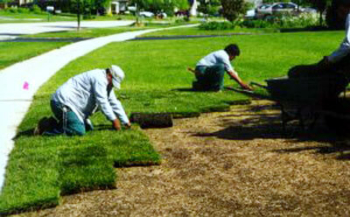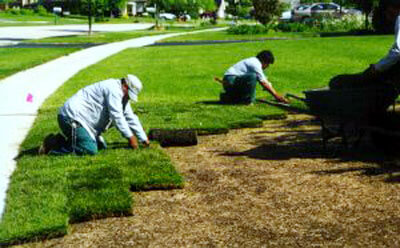
When to plant sod grass? Choosing to lay sod instead of starting with grass seeds is a good idea when your yard is badly damaged, has lots of bare patches, or has been exposed to a lot of foot traffic. It also gives an instant payoff of a green, full lawn.
Once you’ve decided to plant sod in your yard, the next question to answer is when is the best time to plant sod grass? While sod can be planted most times of the year, the grass type and climate of your area help determine the best time of year to start.
On the fence about which method is best for your yard? Check out Seeds vs Sod for North Texas Lawns.
Warm Season Grasses-When to plant sod grass
When to plant sod grass is a question many lawn enthusiasts have an opinion on. For the most part, late spring to early summer is the best time to plant warm season grass varieties. It encourages root growth and quick development before the heat of summer sets in. It also helps it establish itself to help stand up to foot traffic.
A sturdy root system needs to be established early on with plenty of regular watering, and then maintained with deeper, less frequent watering. Late spring to early summer is the peak growing season for warm season grasses, and the temperature is ideal for an effective watering schedule. Temperatures between 65-80 degrees are best for deep root growth because the water will neither freeze nor evaporate.
Avoid laying most kinds of sod when temperatures are over 90, which can lead to the sod drying out too quickly. Choosing the right variety of grass for your area and the needs of your yard also determine the best time to plant.
Here are the three most popular types of sod to plant for the North Texas region:
St Augustine
St Augustine grass is popular because it thrives in warm temperatures and full sun. It also does well in a variety of soil types. It is difficult to grow from seed, so starting off with sod is recommended.
Since it thrives in warmer weather, try planting St. Augustine a little later in the season. Late spring or early summer when temperatures are 80-100 are ideal. This grass type is the only one where we condone breaking the “90 degrees” rule when it comes to laying new sod!
St Augustine does not stand up to foot traffic as well as other varieties, so keep that in mind when choosing this variety for your lawn. That doesn’t mean you need to erect a “keep off the grass sign,” just be mindful of heavy traffic if you have pets and/or children.
Bermuda
Bermuda grass is a hardy variety that can withstand drought conditions and a medium level of rainfall. It is durable and can handle heavier and more frequent foot traffic. This makes it a good backyard turf for families who enjoy a robust outdoor life with frequent barbecues and pool parties.
Bermuda grass goes dormant in the winter so the best time to plant is late spring or early fall. However, it is able to be installed in most seasons, so long as the weather conditions are not extreme.
Zoysia
Zoysia grass does well in hot temperatures and full sun. It is also able to handle moderate shade. Which means it does well in yards with large trees. It has a thick mat that can help choke out weeds, making it a popular and lower-maintenance choice for larger lawns.
Zoysia grass is hard to establish from seeds. So sod is the way to go for this warm season grass. You can lay it in the winter when it is mostly dormant, but the best time is during the spring or fall when the root system is in active growth.
Wrapping Up When to Plant Sod Grass
Let’s go over some things to remember about when to plant sod grass. If you choose to lay sod in the winter, dormant grass will not green up until the spring. But in milder conditions with little to no frost snaps, you can lay and water new sod fairly safely. Regular watering is critical for root growth. So this is only a good idea if you’re confident that freezing weather is not around the corner.
Likewise, when laying in the spring, be sure to watch the weather. Lay sod after most of the possibilities of a freeze have passed. In summer, water several times a day to keep new sod from drying out in higher temperatures. Again, 50-80 degrees is the “sweet spot” for laying sod. Although, this is not a hard and fast rule so long as you are diligent.


One Response
My uncle wants to create an expressive outdoor space that’ll complement his home. I love your suggestion of investing in shaded sod for a unique lawn color. Since he’s aiming for something modern, I think finding a sod expert can help him achieve this.